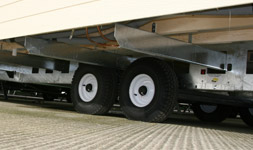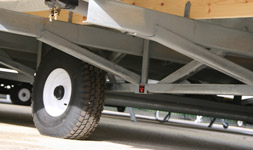Buying a holiday/park home will be one of the most significant investments you will make.
Many of these purchases are made to enjoy for many years and it is important that you can make an informed choice to protect your investment and also
minimise the maintenance you need for your holiday home.
One of the most important parts of the unit is the chassis as this is the foundation on which your home is supported and underpins your investment.
There are three different types of finish that can be applied to the steelwork construction of the chassis. There are significant differences between
each and their ability to perform in certain environments. Knowing and understanding the difference between them is key to ensuring you get the right
chassis for your home.
The following information will allow you to make an informed choice when selecting the chassis you require for the area in which you wish to site
your home. Make sure you understand the differences before starting the purchase procedure and avoid unnecessary maintenance.

Fully Galvanised Chassis
Is your holiday home near the coast?
The fully galvanised chassis is the ONLY chassis recommended for use in estuaries, coastal and areas with high salinity.
These chassis are fully coated in the galvanising process (either as an entire unit or by components that are subsequently joined together by a method that ensures there are no breaks in the coating that may allow corrosion).
There is no periodic maintenance* requirement for this type of chassis. Additionally, the Anti- Corrosion Warranty is typically 12 years from date of chassis manufacture.
With a fully galvanised chassis, you can be safe in the knowledge that your home is protected for years to come.
*Maintenance may be required to wheels, corner-steadies and towing hitches. Consult your owner handbook for details.

Pre Galvanised Chassis
This type of chassis is continually mistaken for a fully galvanised chassis with the same anti-corrosion protection.
This chassis does have galvanised elements to it. However, it is NOT recommended for estuaries, coastal and areas with high salinity.
Without appropriate maintence this type of chassis will show signs of surface rust after a relatively short period of time. However, although the cosmetic appearance of these chassis may look visually poor (rusty) their structural integrity should not be affected for many years.
The method of manufacture uses galvanised sheets that are cut and formed into the required sections to produce the chassis. After cutting the edges and ends of each section do not have the same degree of protection as the faces and will therefore show signs of rust over time.
Likewise the welding of the sections to join them together removes the galvanising layer as such they are treated with a Zinc rich primer. However, over time, these will also show a fine cosmetic film of corrosion.
It is important to know that, due to the above factors, surface rust on this type of chassis is not considered worthy of a warranty claim.
Periodic maintenance will be required on a pre-galvanised chassis. This includes the “touching up” of material bar ends and welds with coating compliant to ISO 12944:C4 and also recommend applying grease/oil to these areas for extra protection.
If this type of chassis is used in coastal areas then the periodic maintenance will be required more frequently (at least on an annual basis).
The Anti-Corrosion Warranty for this chassis is typically only 2 years from date of chassis manufacture.

Painted Chassis
75% of holiday homes are located near the coast. So, it is important to know that this type of painted chassis is NOT recommended for estuaries, coastal and areas with high salinity.
Without appropriate maintence this type of chassis will show signs of surface rust after a relatively short period of time. However, although the cosmetic appearance of these chassis may look visually poor (rusty), their structural integrity should not be affected for 3 years.
The painted chassis is exactly what it says it is! The raw steel of the chassis is painted as the final operation in its manufacture. This option offers the least amount of protection to surface rust and subsequent metal corrosion.
You will need to ensure you have annual maintenance undertaken for this chassis. Whilst the paint used helps prevent rust, it is essential to check for any signs of damage or corrosion. The chassis should be “touched up” using a coating conforming to specification ISO 12944 C4.
Areas requiring repainting should be prepared using a wire brush or abrasive paper to remove rust and flaking paint. Mechanical damage to the paint areas (due to moving or siting) will result in a significant reduction in the paint durability. Any damage must be identified as early as possible and touched up immediately.
The Anti-Corrosion Warranty for this chassis is typically only 1 year from date of chassis manufacture.